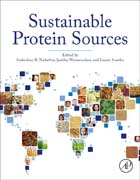
Sustainable Protein Sources
Nadathur, Sudarshan
Wanasundara, Janitha P. D. Dr.
Scanlin, Laurie
Protein plays a critical role in human nutrition. Although animal-derived proteins constitute the majority of the protein we consume, plant-derived proteins can satisfy the same requirement with less environmental impact. Sustainable Protein Sources allows readers to understand how alternative proteins-such as plant, fungal, algal, and insect protein-can take the place of more costly and less efficient animal-based sources. Sustainable Protein Sources presents the various benefits of plant and alternative protein consumption, including those that benefit the environment, population, and consumer trends. The book presents chapter-by-chapter coverage of protein from various sources, including cereals and legumes, oilseeds, pseudocereals, fungi, algae, and insects. It assesses the nutrition, uses, functions, benefits, and challenges of each of these proteins. The book also explores opportunities to improve utilization and addresses everything from ways in which to increase consumer acceptability, to methods of improving the taste of products containing these proteins, to the ways in which policies can affect the use of plant-derived proteins. In addition, the book delves into food security and political issues which affect the type of crops that are cultivated and the sources of food proteins. The book concludes with required consumer choices-such as dietary changes-and future research ideas that necessitate vigorous debate for a sustainable planet. Introduces the need to shift current animal-derived protein sources to those that are more plant-basedPresents a valuable compendium on plant and alternate protein sources covering land, water, and energy uses for each type of protein sourceDiscusses nutritive values of each protein source and compares each alternate protein to more complete proteinsProvides an overview of production, including processing, protein isolation, use cases, and functionalityPresents solutions to challenges, along with taste modulationFocuses on non-animal derived proteinsIdentifies paths and choices that require consumer and policymaker debate and action INDICE: 1. Proteins in the Diet: Challenges in Feeding the Global Population PART 1: PLANT-DERIVED PROTEINS 2. Soy Protein: Impacts, Production and Applications 3. Rice Protein and Rice Protein Products 4. Wheat Proteins 5. Proteins from Sorghum and Millets 6. Oat Protein 7. Hemp Seed (Cannabis sativa L.) Proteins 8. Protein from Flaxseed (Linum usitatissimum) 9. Proteins from Pulses: Peas and Beans 10. Lupin: An Important Protein and Nutrient Source 11. Proteins from Lentils 12. Underutilized Proten Resources from African Legumes 13. Peanut Products as a Protein Source 14. Quinoa as a Sustainable Protein Source 15. Amaranth: Food and Nutraceutical Purposes 16. Amaranth: Sustainability, Processing and Food Uses 17. Chia: The New Golden Seed for the 21st Century PART 2: UPCOMING SOURCES OF PROTEINS 18. Proteins from Canola/Rapeseed: Current Status 19. MycoproteinL A Healthy New Protein with a Low Environmental Impact 20. Heterotrophic Microalgae: A Scalabale and Sustainable Protein Source 21. Edible Insects: A Neglected and Promising Protein Source PART 3: CONSUMERS AND SUSTAINABILITY 22. Meat Reduction and Plant-Based Food: Replacement of Meat--Nutritional, Health, and Social Aspects 23. Flavors, Taste Preferences and the Consumer: Taste Modulation and Influencing Change in Dietary Patterns for a Sustainable Earth 24. Food Security and Policy 25. Feeding the Globe Nutritious Food in 2050: Obligations and Ethical Choices
- ISBN: 978-0-12-802778-3
- Editorial: Academic Press
- Encuadernacion: Cartoné
- Páginas: 452
- Fecha Publicación: 01/10/2016
- Nº Volúmenes: 1
- Idioma: Inglés
